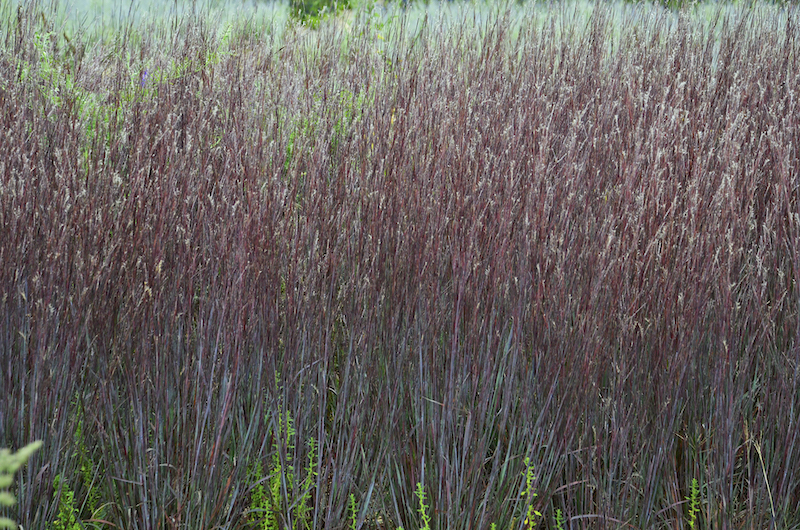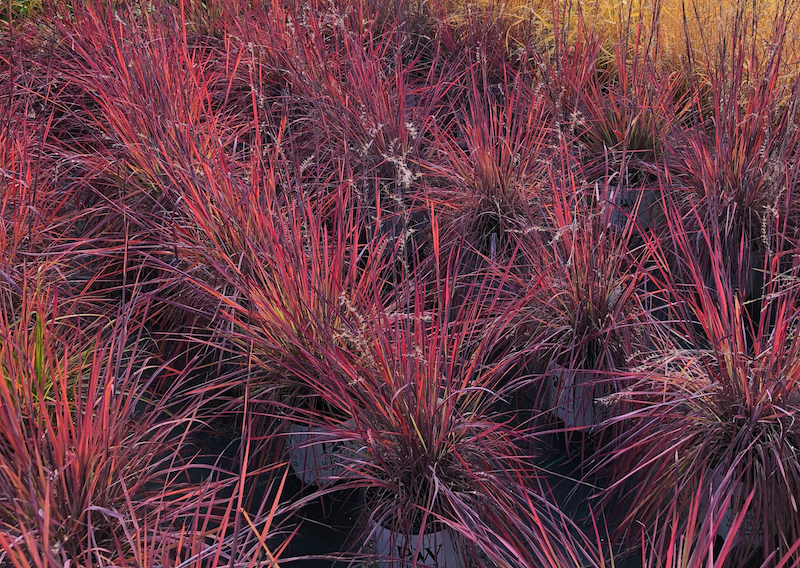Growing Bluestem Grass
In the nursery trade, bluestem grasses consist mostly of little bluestem (Schizachyrium scoparium) and big bluestem (Andropogon gerardii). As the name implies, little bluestem is much smaller than big bluestem and only reaches between 1 and 3 feet high. Big bluestem varieties can reach 8 feet high and spread by rhizomes. Otherwise, the two species have very similar cultural requirements and are easy to grow.
Bluestem grasses are native prairie grasses that are often used for erosion control and restoration plantings. They form arching, upright clumps that flower in the summer. These are warm-season grasses that do most of their growing during the warm summer months and go dormant in late fall to winter. Various cultivars with outstanding color and hardiness qualities are now commonly available in garden centers. These grasses create beautiful waves of color and movement when planted in drifts for a meadow or prairie garden.

Planting Bluestem Grass
Bluestem grasses perform best in full sun, with at least 6 – 8 hours of direct sunlight per day, although big bluestem can tolerate partial shade. They adapt to various soil conditions, including dry, poor, clay, gritty, sandy, and average soils. They do not tolerate standing water or very alkaline soils.
Find a sunny location with well-draining soil, and dig a hole just wide enough for the root ball. Set the crowns slightly above the soil surface to prevent crown rot. Backfill the hole with native soil and water thoroughly to fill in any air gaps around the roots. Add a layer of organic compost around the root zone to conserve moisture.
Watering Bluestem Grass
Water new plants regularly over the summer to establish drought tolerance. The plant needs supplemental water in early establishment stages, but thereafter is quite self-sufficient except in severe drought. It tends to go dormant without moisture, so the best appearance is preserved with weekly watering, especially those plants in containers.
Fountain grass is considered drought tolerant. Once established, it will only need occasional supplemental water in the summer. During the first two growing seasons, water this grass regularly to establish a strong root system. Even established plants should be watered weekly during hot, dry spells to keep these grasses looking fresh.
Grasses grown in pots dry out more frequently than those in the ground and should be watered when the soil feels dry to the touch. This is usually once or twice a week in the summer.
Fertilizing Bluestem Grass
Bluestem grasses grow well in poor soils and do not need to be fertilized. If a soil test shows that your soil is deficient in nitrogen, you can apply a slow-release, general-purpose fertilizer in the spring. Choose a formula with a 10-10-10 balanced N-P-K ratio. Use a light application as too much nitrogen can cause grasses to flop. Alternatively, try topdressing the root zone with organic compost each spring to improve your soil content.
Pruning Plant Bluestem Grass
Both big and little bluestems will die back and go dormant over the winter. Leave the seedheads and spent foliage in place to feed and shelter wildlife over the winter. In early spring, cut this grass back hard before new growth starts. Use a pair of sharp, sterilized pruning shears to cut the stems to a few inches above the ground.
Caring For Bluestem Grass in Pots
Little bluestem cultivars are particularly well-suited to growing in containers because of their small size and attractive color. If you are planning to leave the container outdoors all year, choose a weather-resistant container, and make sure the drainage holes allow for fast drainage. Bluestem grasses have large root systems, so choose a container several inches larger than the rootball.
Use an all-purpose potting soil that is for formulated for container plants. Pot the grass only as deep as it was originally planted, and leave a couple inches at the top of the container for watering. Water whenever the top two inches of soil feel dry, and apply a well-balanced fertilizer at half strength in the spring.

Winter Care for Bluestem Grass
Most bluestem grasses are cold hardy to zone 3 and will not need any special winter care. At the colder end of its range, you can apply a thick layer of mulch around the base of the grass to protect the crown from hard freezes during the winter. In the spring, cut this grass back to a few inches above the ground and pull back the mulch to prevent crown rot.

Common Bluestem Grass Care Questions
Is Bluestem Grass Invasive?
Little Bluestem can be a little invasive, as it tends to self sow in a rather vigorous, but this can be controlled by cutting off the seeds heads before they have a chance to mature (before they turn a feathery white in early fall.) Removal of seed heads does take away some of the visual interest. Little Bluestem do also spread by side shoots, which can be dug up and transplanted for additional plants in other areas.
What Is Bluestem Grass Used For?
Little Bluestem is often used as a transition plant between manicured landscapes and grasslands or forest. Little Bluestem is also useful as erosion control on sloping ground or along ravines, as it has extensive, fibrous, deep root systems which also have a horizontal reach.
How Fast Does Little Bluestem Grass Grow?
Little Bluestem can take a year or two to fully establish, at which point they'll reach 2 to 3 feet tall and once the flower stalks come on, may reach up to 5 feet high by the end of summer.
Is Bluestem Grass Deer Resistant?
Little Bluestem, once established, is deer and rabbit, as well as drought and heat, resistant.
Is Bluestem Grass Poisonous?
Little Bluestem is not poisonous, and is grazed by a variety of animals, cattle, horses, deer and birds. It has not been found to be poisonous to dogs or cats, according to the ASPCA website.
Is Bluestem Grass Edible?
Although Little Bluestem is not poisonous, it is not for human consumption.
Bluestem Grass Isn't Blooming
Little Bluestem is a warm season grass, and should really take off mid-summer. For best performance and maximum flowering, make sure it's planted where it's getting full sun and the soil drains well, it doesn't like wet, soggy feet!
Have a question about bluestem grass? Fill out the form below and we will try and get back to your question as soon as possible. We may even feature your question in this article to help other gardeners!
 |
Author Jessica Mercer - Published 7-13-2022 |
